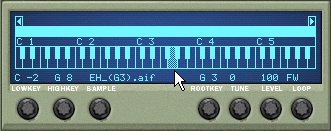Find Some Sounds
- Search for sounds at the following web sites (and any other
sites you discover).
- The Freesound Project
- SoundBible
- Political speeches
- ccMixter (remix resources)
- Music Machines (samples of old synths)
- FindSounds (search the web for sounds)
These sites all work differently, but in general, when you click on a sound, it will open a QuickTime player window that lets you play the sound. If you want to download the sound, you have to do something else. In Safari, right-click (click with the right mouse button) on the sound link, and choose Download Linked File from the menu that appears. Save it to the Desktop so that you can find it later.
Some older web sites use Flash to play sounds, and they might provide a download button.
Don’t bother downloading files in Windows Media (.wma) or RealAudio (.ram) format. We can’t easily convert those into a form that Reason likes. Wave (.wav) and AIFF (.aif), are best; some compressed file (e.g., MP3 and AAC) files will work also.
DO THIS: Obtain at least two sound files.



